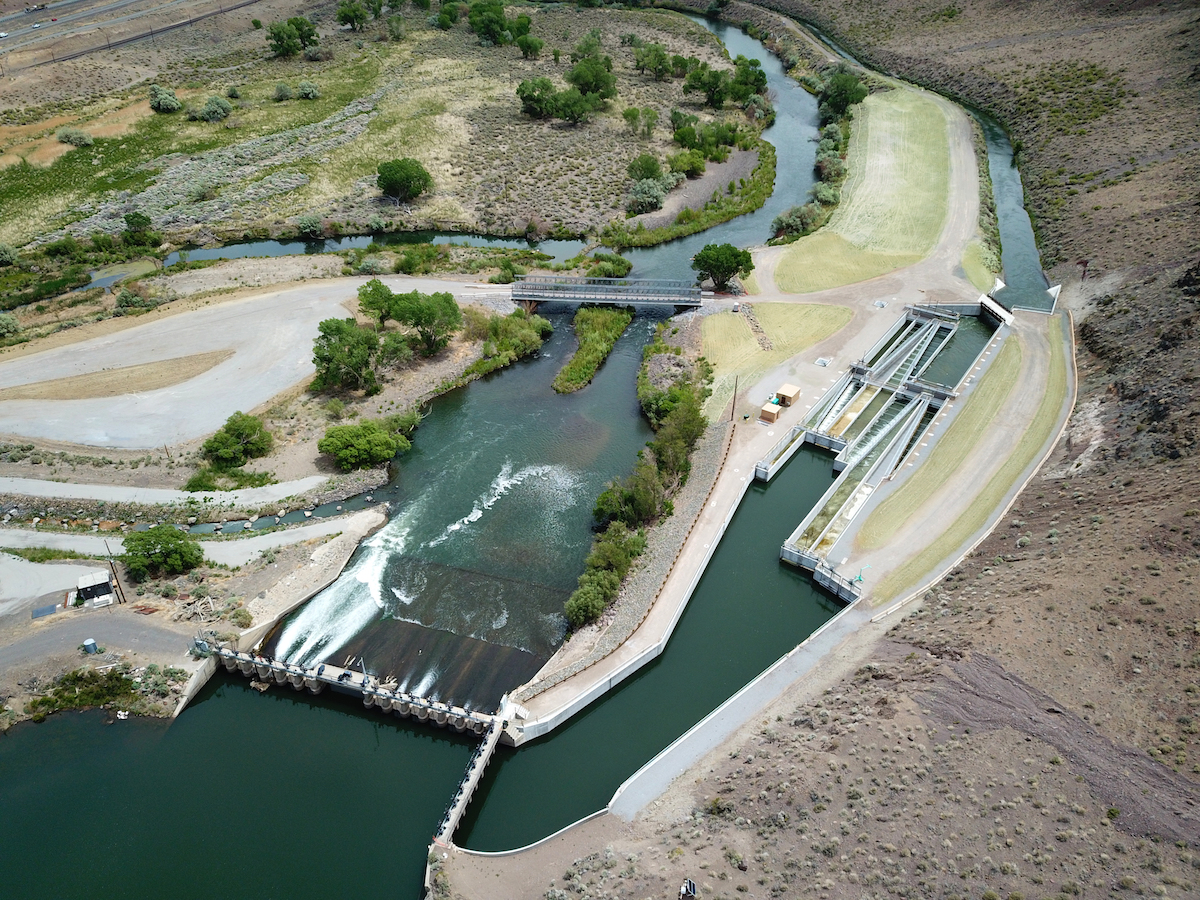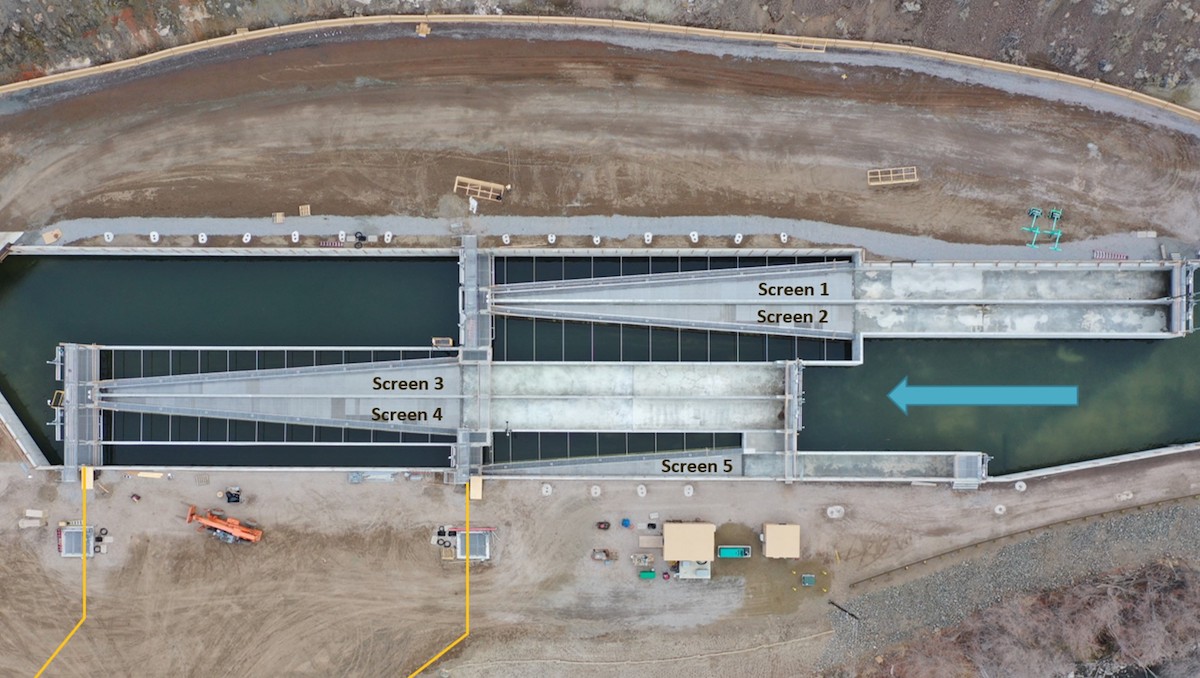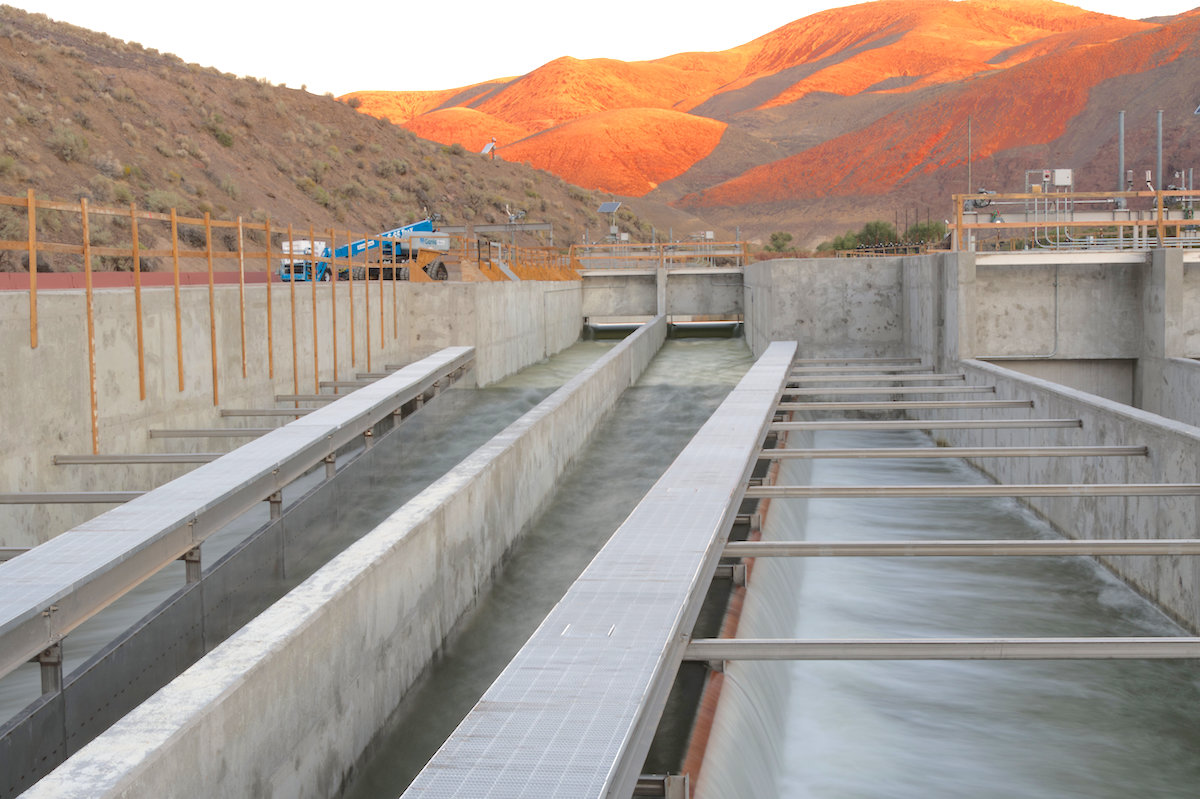A view looking north shows a flowing Truckee River, the Derby Dam and newly completed fish screens in this 2020 photo.
 Farmers Conservation Alliance
Farmers Conservation Alliance
“Reclamation wanted to reclaim the land,” Schoenfeld said, adding the agency also had a plan to add water to another tributary. “They thought they would augment water on the Carson River side with water from the Truckee side. That was always the plan, and that’s what we did.”
Schoenfeld also said the Truckee Meadows, which is the home of Reno and Sparks, increased its use of water for farming. He said the water diversions to farmers, however, caused another problem. He said the Pyramid Lake level dropped 40 feet in the 1940s.
To get to that point, however, Schoenfeld said Reclamation built the Lake Tahoe Dam at Tahoe City to regulate water storage for downriver use. Additionally, he said the four power plants were build downstream. Truckee River General Electric had owned the dam before selling it to Reclamation in 1915. The Truckee River Agreement that was finalized in 1935 provided a framework for water usage.
The Floriston Rates or flow rates, therefore, confirmed a flow of 300 to 500 cfs (cubic foot per second) in the river dependent on the amount of Lake Tahoe water. Schoenfeld said the agreement confirmed a maximum water surface elevation of Lake Tahoe of 6,229.1 feet, which, ironically, could see the water fall below the rim later this month. Floriston is located on the Nevada-California border off Interstate 80.
“Reclamation saw a big river system to get water out of it,” Schoenfeld added.
 Farmers Conservation Alliance
Farmers Conservation Alliance
According to “Drought In Nevada,” “The Floriston Rates represent minimum flow rates that have to be met with water flowing from Lake Tahoe, any creeks tributary to the Truckee River and the several upstream reservoirs that impound water.”
The established rates based on the federally established operating agreement call for the average flow in the Truckee Rover at 500 cfs from March 1 to the end of September, and the average flow of 400 cfs for the other six months.
“The agreement also required the construction of Boca Dam because they (Reclamation) needed another reservoir,” Schoenfeld said.
Boca Dam is six miles northeast of Truckee on the Little Truckee River.
“Back then, it was about electricity, and that’s how Boca Dam helped the Floriston Rate,” he said.
Schoenfeld said Washoe County farmers saw an opportunity for the federal government to help them with water for their crops. The farmers didn’t want to see the water go downstream; instead, they wanted as much river water as possible to help them.
In 1944, Schoenfeld said the Orr Ditch Decree was finalized and established both individual water rights and water rights to the Pyramid Lake Indian Reservation. Schoenfeld said the decree authorized water storage of up to 6 feet in the dammed-up Lake Tahoe, which amounted to 744,000 acre-feet of water. One acre-foot equals about 326,000 gallons or enough water to cover an acre of land. Lahontan Reservoir, for example, holds 308,000 acre feet.
The Washoe Project authorized in 1956 allowed for the construction of Prosser Creek Dam and reservoir that both maintained minimum flow between Lake Tahoe and Boca.
Stampede Dam and reservoir was completed in 1970 as part of the Washoe Project, which was authorized in 1956. According to Reclamation, “the water storage capacity is 226,500 acre-feet which is reserved by court decree for fishery enhancement, primarily for the spawning of the endangered cui-ui, along the Truckee River downstream from Derby Dam and facilities operation of the Pyramid Lake Fishway.
“The reservoir provides water primarily for fishery enhancement along the Truckee River and Pyramid Lake Fishway facilities operation. The reservoir also provides flood control, recreation, a reservoir fishery and other fishery improvements on the main Truckee River, Little Truckee River, and Boca Reservoir.”
Kaler said a project to help the Lahontan cutthroat trout (LCT) access to its spawning grounds for the first time in decades was completed one year ago. He said Reclamation and the Farmers Conservation Alliance, a nonprofit organization, completed a horizontal stainless steel fish screen south of Derby Dam and near the Truckee Canal headwaters. For years, though, Schoenfeld said the LCT was thought to be extinct.
The FCA website said the technology afforded with a fish screen allows the diversion of water from rivers without harming fish or trapping debris. FCA said it works with agencies, farmers and engineers to design and install the screens.
“It’s a highly managed river system, and a lot of people rely on this water,” Kaler said.
According to Reclamation, the fish screen with give the LCT a way to maneuver around Derby Dam and allow the LCT to swim upstream in the Truckee River to Reno. Additionally, this will allow Reclamation, the U.S. Fish and Wildlife Service’s (USFWS) National Fish Hatchery Complex and the Pyramid Lake Paiute Tribe “to restore connectivity to the federally threatened LCT.”
Kaler said the USFWS cares about threatened and in-danger fish.
Reclamation broke ground on the fish screen in November 2019 with site preparation, and beginning on Jan. 8, 2020, construction crews began installing a culvert and concrete. Kaler said the first of screens were installed in June 2020 and by September, Reclamation had a fully functional fish screen.
“This was a huge project for us,” Kaler said.
He said the coronavirus pandemic was a hurdle, but the project was able to keep workers employed. When asked about the cost, Kaler said the price tag on the fish screen was $33 million.
 Farmers Conservation Alliance
Farmers Conservation Alliance
Comments
Use the comment form below to begin a discussion about this content.
Sign in to comment